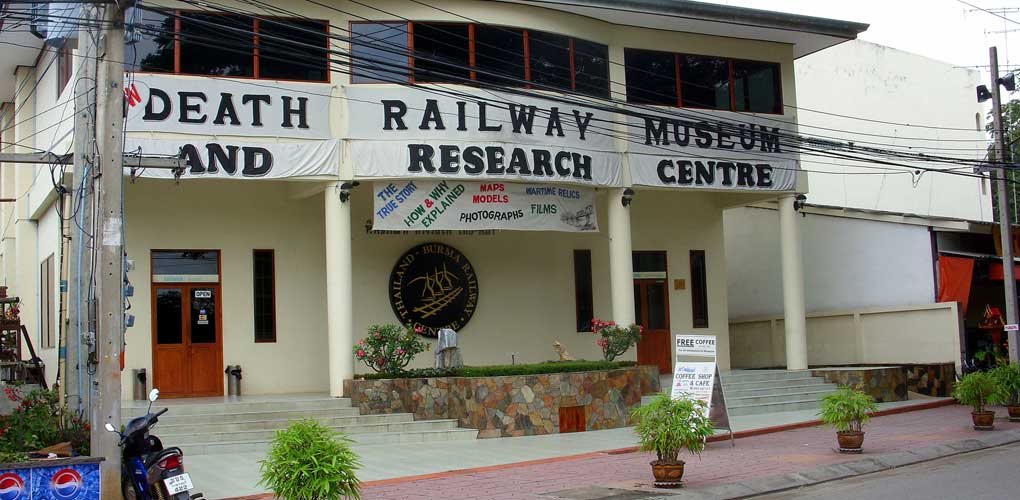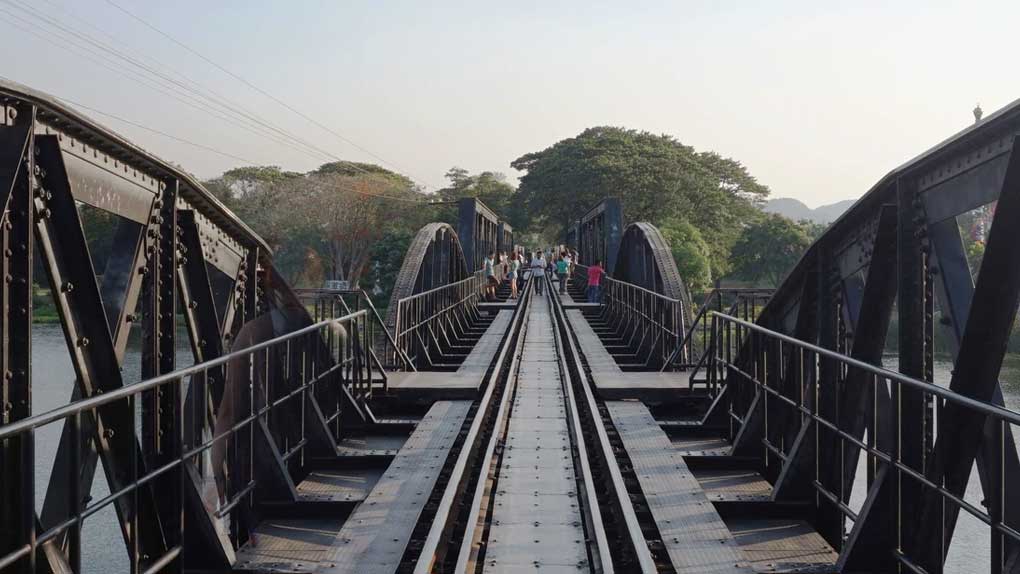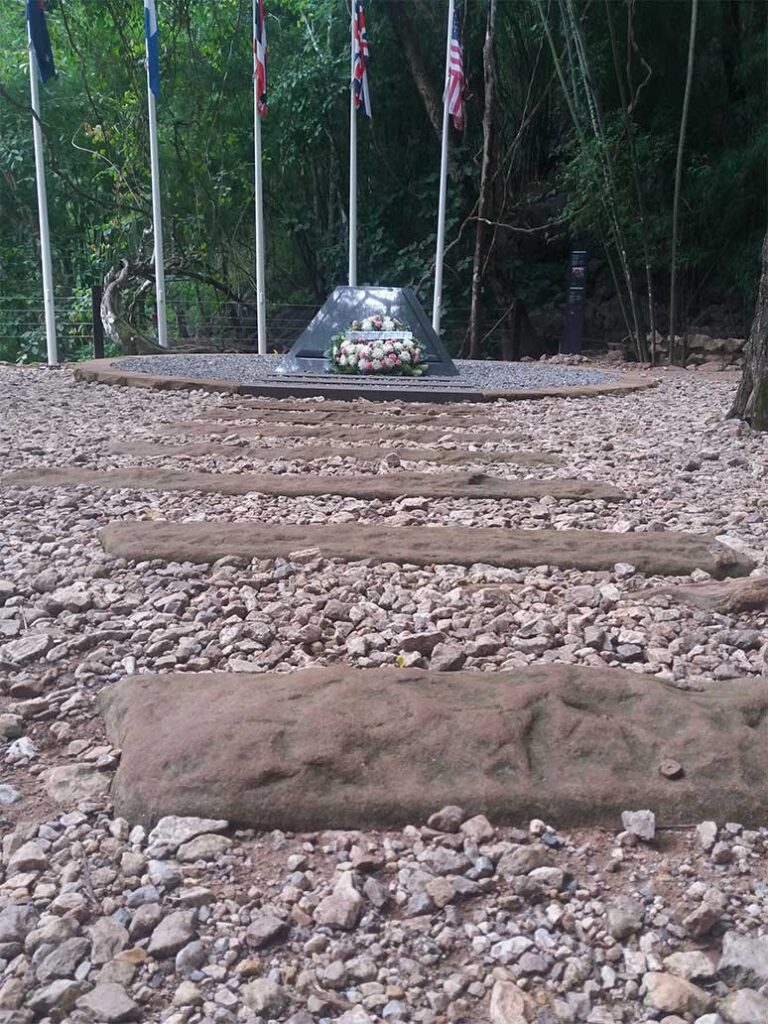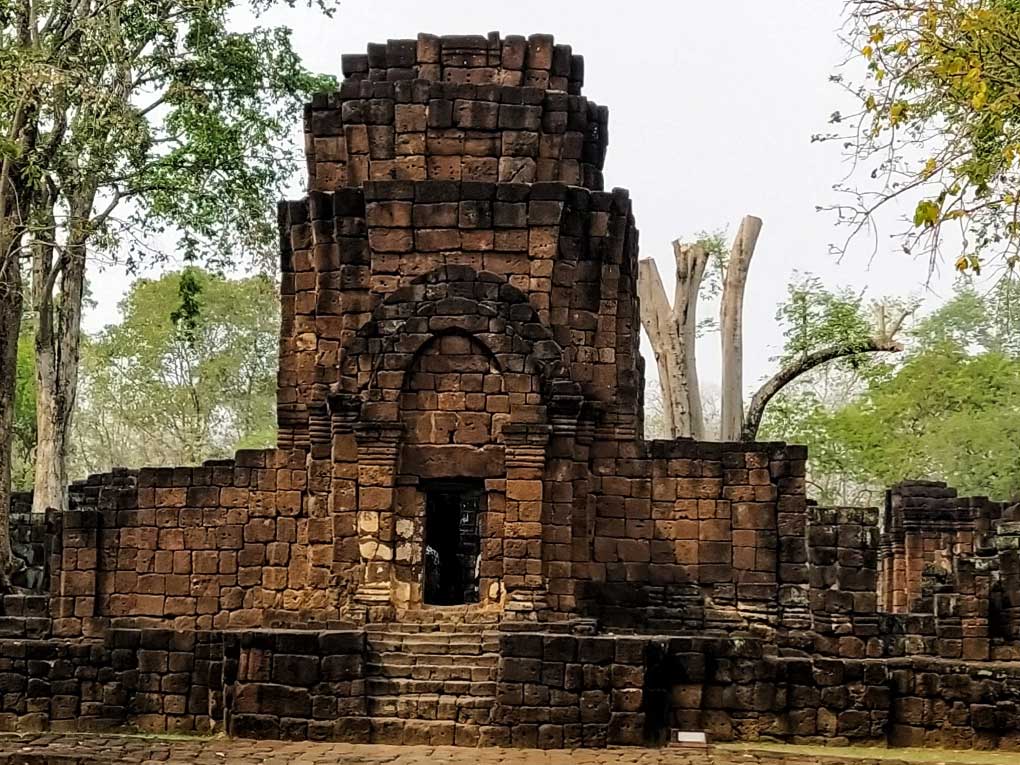The location of the province of Kanchanaburi, bordering Burma and not far from Bangkok, makes it a place rich in history and culture. Many visits to this region are linked to the events that took place in the region during WWII. Whether built by man or by nature, the landscapes that this beautiful region will offer you are breathtaking …
About the war:
Others
First thing to do: Visit to the Death Railway Museum


It is the first thing to do and see when you arrive in Kanchanaburi. Indeed, if you want to understand what happened in this province during WWII, go visit this museum first. After this visit, it will be much easier to continue your travel journey to the different sites and understand the events that took place in the province of Kanchanaburi.
The Thailand-Burma Railway Centre is an interactive museum, information and research facility dedicated to presenting the history of the Thailand-Burma Railway. This ran 415 km from Ban Pong in Thailand to Thanbuyuzayat in Burma and was built by the Imperial Japanese Army during the Second World War using Allied prisoners of war and impressed Asian labourers.
The museum is very professional and gives a very wide yet detailed presentation of the war in this area in particular. There are ample photos and other memorabilia that will give a very clear presentation of the depredations inflicted by the Japanese military in building the nearby bridge and railway stretching from Thailand through Burma.
This is not a stuffy museum but a very moving one. If you think you know about this railway then you will realise that you know very little when you get here. Make sure you have enough time to do this museum as there is a lot of to read and see. It is on two floors and has toilets, a café and a small shop.
Inside the town and also not too far from the train station, The Death Railway Museum has fully air-conditioned and offers to the visitor an educational and moving experience. It’s open every day from 9:00 am to 4:00 pm, subject to official Thai closure regulations.
The Bridge over the River Kwai, an iconic monument of Kanchanaburi.

During World War II, Japanese soldiers forced thousands of prisoners to build the Bridge over the River Kwai, at the cost of many lives. The railroad that it supports was to link Bangkok to Burma.
Little advice for discovering the bridge from another angle is either, to rent a flat-bottomed boat a little further downstream that takes you under the bridge or to buy a train ticket and arrive on the bridge via the railway. Of course, you can also take a walk on the bridge..beware of the train :).
The best time to visit the bridge is early… I said early at sunset, nobody there and you will have plenty of time to take some nice photography.
Pay a respect at The War Cemetery Kanchanaburi

The cemetery is across the street from the Death Railway Museum.
It is a stop to make. This cemetery is very well maintained. One thing immediately you will notice is the young age of the people buried here.
Walk on the old railway at the Hellfire Pass Memorial Museum.



The entrance into the museum is dark and on the walls, you can read the names of everyone who worked on the railway. While you are in this tunnel, you can listen to the sound like you was there as a prisoner. If you want you can have an audio headset for the trek.
Hellfire pass is a must-do, a place for all ages and levels of fitness. In the first part, you walk on wood stairs and on a gravel way. Some wooden benches are along the path to stop and admire the view.
The second part of the trail (the shortest way) is with some concrete stairs to come back to the parking lot. While you climb the stairs, listen to the bamboo sound.
During the walk, the view is overlooking the path is epic, and the historical symbolism of the place is just overwhelming.
As you walk along the Hellfire pass, there are a lot of informative signs telling you about the POWs that worked there and general information about where you are and what happened there.
Walking inside this pass makes you realize how it was for these Pows.
How hard it was to dig into the rock to build tracks of the railway. The small holes in the rocks are where the prisoners inserted dynamite to detonate the rock.
This museum was made by the Australian government, well maintained and a must to see..
Outside the Kanchanaburi town at +/- 90 km from the city centre.
Get a ride on the Death Railway Train
The major attraction recommended in Kanchanaburi is to take a ride on the famous Death Railway.
Cross those steep trenches and wooden bridges that wind along the river crossing the famous bridge over the River Kwai. You have to take a minibus to a train station along route 3228.
Departure from Tha kilen station for example, but the best is to leave from Thamkra Sae station (map). At this station, you will have a view of the railway line on the mountainside and as a bonus, you can visit the Kasae cave, former bomb shelter and the Wampo viaduct.
On this ride to Kanchanaburi, you will get some great views as the train slows down as it passes along the river and cliffs, just make sure not to place your head too far out the window as the train passes by cliffs and branches.
Best early morning view
I will never repeat myself, but the best part of Thailand is to wake up early, walk in the street or go to travel attractions.
As a result, that is the best way to have beautiful pictures/videos done without the mass of tourists. The bridge at sunrise is amazing.
The best temple in kanchanaburi: Wat Tham Suea (Tiger Cave Temple)

Wat Tham Suea is the most famous temple in Kanchanaburi province.
The temple is located about ten kilometres from the city. It seems to be sitting on a rocky mount, between the Mae Klong river and the rice fields. In addition to its monumental size and original setting, several original features make this statue a Buddha apart in Thailand:
There is the hull, which largely encloses it. Then there is the gesture of his hands, forming the vitarka-mudrā, or the gesture of teaching and argumentation. Ultimate originality: golden mosaics cover its body, hence its sparkling appearance.
Opposite the complex is a pagoda overlooking the giant Buddha. There are seven floors to climb, the last containing sacred relics. During the ascent, look through the windows to see a magnificent panorama: the river to the north, the giant Buddha to the west, the rice fields to the south, and the Chinese pagoda of the neighbouring temple to the southeast, Wat Tham Khao Noi.
Returning to the level of the giant Buddha, the visit continues by a narrow staircase going down to the car park.
Before reaching the bottom of the hill, do not miss a rock shelter that gave its name to the monastery: The Tiger Cave (Tham Suea) extends into a rock cavity. As its name suggests, it is dedicated to a legendary tiger.
Near this cave, a large hall presents the preserved body of Luang Po Chun Pasatiko, the former chief abbot of the monastery. His remains are in a transparent coffin raised on a richly decorated pavilion.
A not miss, the spectacular Wat Ban Tham

Wat Ban Tham is one of the spectacular temples in Kanchanaburi province. It is located on the right bank of the Mae Klong river and not very far from the Wat Tham Suea.
Like several surrounding temples, Wat Ban Tham is part of the mountain. You will have to trudge to find out.
The climb has three parts. here are the first two:
- The first begins with a straight staircase up to the mouth of a dragon created in 1995.
- The line continues through its wavy body, decorated with murals. Once out of the tunnel, the entrance to the cave looms.
This vast cave is named Tham Khuha Mangkon Sawan, or the cave of the celestial dragon. It hosts several sanctuaries with animist tendencies, as well as an imposing Buddha watered by natural light. This rocky cavity has been a religious and strategic site for several centuries because it offers an unobstructed view of the river and the surrounding area.
The Buddha himself is said to have been installed early as the Ayutthaya period, although the exact century remains a mystery. After having made the tour of the place, it is necessary to identify a spiralling metal staircase. It allows you to exit the cave from the top.
Third part
The ascent then continues via a landscaped slope in the middle of nature. There are small cavities along the way, but you should know that there are nine in the surrounding area!
In the end, you will reach a golden stupa, the perfect vantage point to admire the region.
In total, the ascent is via more than 700 steps!
The Kuang-Im Chapel

The Kuang-Im Chapel is a Chinese-style Buddhist temple located on the banks of The River Kwai, very close to the bridge. In this complex, there are two-storeyed buildings where you will find the old temple and the new. The new temple consists of three floors with exquisite carved Chinese gods, goddesses and Buddhist images. This temple complex is worth visiting since it shows all the 10 prominent gods and goddesses as stated in mythologies.
Discover the Khmers ruins at Prasat Muang Singh National Park.

The Prasat Muang Singh is a Khmer complex whose central element is the ruins of its temple dedicated to the Hindu god Shiva. These are the most westerly outpost remains of the Khmer Empire discovered in Thailand. Its construction dates from the 13th and 14th centuries. The city was abandoned until the reign of King Rama I (1782-1809). Muang Sing stretches along the banks of the Kwai Noi River, high enclosure walls are built of laterite, the entry and exit gates are located on 4 sides, there are 6 ponds and 4 main religious structures to visit.
Muang Singh was declared a historical park in 1987. It is not the most noticeable Khmer site in Thailand. The most beautiful temples of this style remain that of Phimai, Phanom Rung and Prasat Muang Tham.
Have fun at the best waterfall in Thailand, Erawan Waterfalls:

if you are interested in nature, wildlife, trekking and hiking and even camping. it’s probably the most beautiful place in the country. its located at around +/- 90 km from Kanchanaburi centre and it worst to go.
You will walk on 7 levels which each contains fall and small ponds.
You can swim at each level and relax. If you want to experience the Thai jungle, Erawan waterfall is the place to go.
Complete article on Erawan here
At Sai Yok, look for the smallest species of bat and arguably the world’s smallest mammal.

The waterfalls of Kanchanaburi province are the most famous in Thailand. The little sister of the Erawan waterfalls is no less attractive. Say Yok Yai (large) and Sai Yok Noi (small) were once frequented by King Rama V. At the bend of a path, keep your eyes peeled for beautiful colourful orchids or rare animals such as the bat Kitti, the smallest mammal in the world. From Sai Yok, you can also trek to the Kanchanaburi caves. Please note: Use a headlamp because the entrance is sometimes narrow.
Get drunk for …10 Baht

Yes, it’s true. It’s probably the cheapest bar in Thailand.
A very nice place to start your evening, without going bankrupt 🙂 shooters start at 10 bahts, Samsong coke, 30 Baths…
The bar is along the street and it’s 5 meters long, so not too many bar tools. There are a few tables on the sidewalk and chairs and paint pots… are tools. More info about the 10 baht bar


Dest Apart says:
More places to come during this month, stay tuned